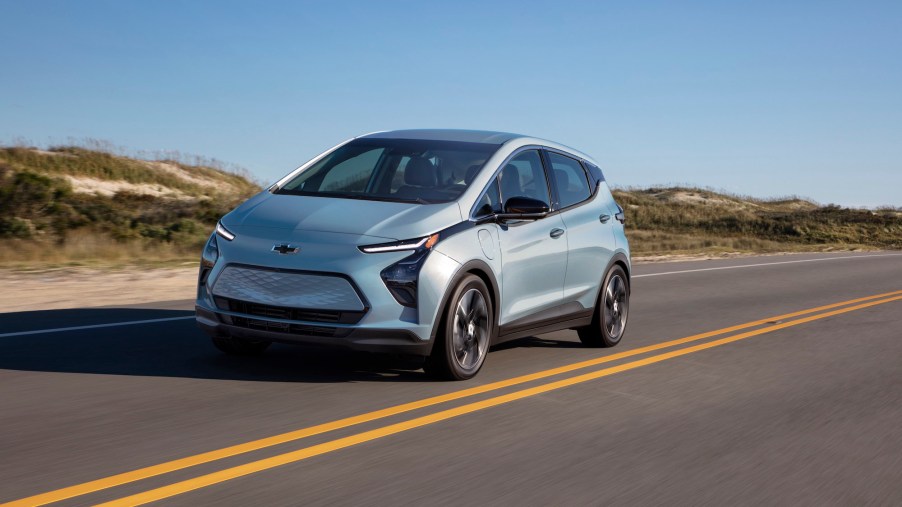
Chevy Got Dangerously Close to Dethroning the Tesla Model 3
Chevrolet recently made headlines for outselling Ford in the full-size pickup truck category last year. Now it seems the bowtie brand aims to steal the throne from Tesla by producing the best electric vehicle. As a result, the Tesla Model 3 Standard Range Plus is no longer the most affordable yet stylish EV. And if Chevy keeps it up, that might not be the only Tesla model to get knocked down a few pegs.
The 2021 Chevy Bolt tied with the Tesla Model 3 in Consumer Reports’ rankings
Consumer Reports recently published a vehicle rating report in which the 2021 Chevy Bolt tied with the 2021 Tesla Model 3. Both EVs earned an overall score of 78 from CR. But the Model 3 earned a higher road test score of 82 than the Chevy Bolt’s 76. Chevrolet first began production of the Bolt in 2016 for the 2017 model year. That means it’s been around as long as the Model 3.
In January 2020, Kelley Blue Book (KBB) published a report suggesting U.S. consumers paid roughly $38,000 for a new car on average. The Chevy Bolt and Tesla Model 3 Standard Range Plus fall right in line with what most Americans can afford. Adding to that, battery electric vehicles like the Bolt appeal to a broader market than many of Tesla’s EVs.
Chevy Bolt vs. Tesla Model 3
Trying to find reasonable comparisons between the economy-minded Chevy Bolt and the semi-luxury Tesla Model 3 is like looking for similarities between copper and gold. Nevertheless, the Chevy Bolt does offer some creature comforts the Tesla Model 3 lacks. For example, the Bolt includes Apple CarPlay and Android Auto integration. Tesla uses only its proprietary software.
Like the Model 3, the Bolt also has a minimalistic interior. But that’s where the similarities end. Whereas the Bolt’s interior is composed of low-grade plastics, the Model 3’s interior is every bit luxurious. Though more minimalistic than its luxury counterparts, the Tesla Model 3’s interior is good-looking, posh, and noticeably distinct from its competitors.
With everything in the car controlled via its 15-inch touchscreen, there are no buttons or knobs on the dash. Everything from adjusting the mirrors to turning on the windshield wipers is operated this way. On top of that, the screen has top-notch graphics. The Chevy Bolt, on the other hand, has physical controls below its 10.2-inch touchscreen.
Nonetheless, huge surprises are in store when comparing the Chevy Bolt’s and Tesla Model 3’s overall driving performance. The Bolt’s optional electric motor produces 200 hp and 266 lb-ft of torque; the Model 3 Standard Range Plus produces 450 hp and 472 lb-ft of torque. The Bolt can accelerate from 0 to 60 mph in 6.5 seconds, while the Model 3 gets a 5.3-second split. The Bolt has an EPA-estimated range of 259 miles, compared to the Model 3’s EPA-estimated 263 miles.
But the biggest shock is that the 2021 Chevy Bolt costs only about $2,000 less than the Tesla Model 3 Standard Range Plus. According to Chevrolet, the 2021 Bolt Premier costs $42,695. The Tesla Model 3 Long Range’s price is $46,990.
GM aspires to introduce 30 electric vehicles by 2025
A quote from a recent New York Times article lays it out perfectly: “A new president took office this month determined to fight climate change. Wall Street investors think Tesla is worth more than General Motors, Toyota, Volkswagen, and Ford put together. And China, the world’s biggest car market, recently ordered that most new cars be powered by electricity in just 15 years.” The writing has been on the wall for some time, but it appears to have been written in invisible ink.
The number of tech startups–turned–EV crusaders that have popped up over the years shows that stubbornness rather than blindness prevented GM (and Ford) from acting sooner. This is quite surprising, considering GM was the first American automaker to mass-produce and lease an electric car. It was called the General Motors EV1 and was in production between 1996 and 1999. Maybe GM got nervous about Y2K.
This is meant to point out that if any major North American automaker is equipped to challenge Tesla, GM would be the one. The second-generation EV1 already had a range of 100 to 140 miles per charge. Today, the Chevy Bolt has nearly the same range as the Tesla Model 3 Standard Range Plus. And with GM’s aggressive plan to introduce 30 EVs by 2025, there’s no doubt Chevy is headed in the right direction.


